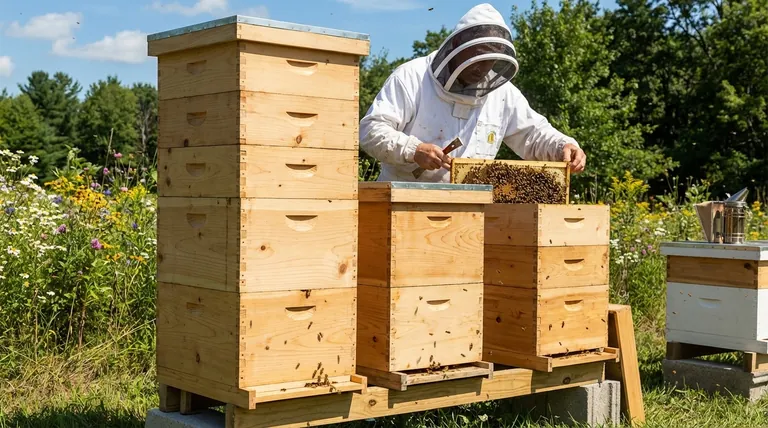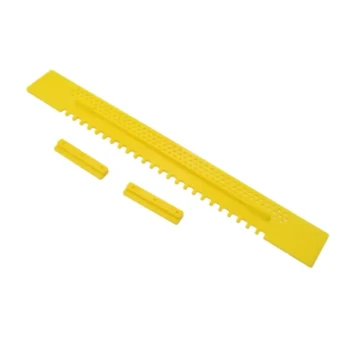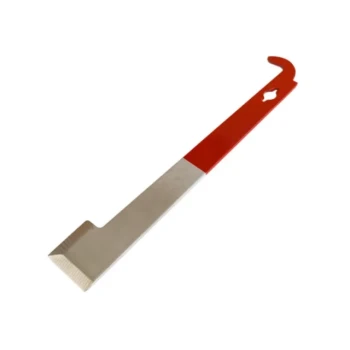At its core, the most common hive configurations involve using either one or two large "deep" boxes for the brood chamber, with smaller "super" boxes added on top for honey storage. These hive boxes are typically built to hold either eight or ten frames, with the primary advantage of eight-frame equipment being its significantly lighter weight and easier handling.
The choice of a hive configuration is not about finding the "best" one, but about understanding the fundamental trade-off. You are balancing the colony's need for space against your own physical ability to lift and manage the equipment.

The Two Core Decisions: Width and Depth
Every Langstroth hive setup is defined by two independent choices you must make. The first is the width (frame count), and the second is the depth (box height).
Your decision on these two factors will determine the weight of your boxes, the total volume of your hive, and the interchangeability of your equipment.
Choosing Your Hive Width: 8-Frame vs. 10-Frame
The width of a hive box determines how many frames it can hold. This is the first fundamental choice you will make, as all subsequent boxes for that hive must match.
The 10-Frame Standard
For decades, the 10-frame hive has been the commercial standard in beekeeping. It offers the most space per box for both brood and honey.
This larger internal volume means a colony can expand significantly before needing another box, and you can store more honey in a single super. However, this space comes at the cost of significant weight.
The Lighter 8-Frame Alternative
The 8-frame hive is a direct response to the physical demands of lifting heavy 10-frame boxes. It is about 20% narrower and, more importantly, 20% lighter when full.
This reduction in weight makes hive inspections and honey harvesting far more manageable, especially for beekeepers with back problems or limited physical strength. The trade-off is that you have less space per box, meaning a strong colony may require a taller stack of boxes to achieve the same internal volume.
Choosing Your Hive Depth: Deep, Medium, and Shallow
The depth, or height, of a box generally corresponds to its purpose within the hive. Unlike width, you can mix and match box depths on a single hive.
Deep Boxes (9 5/8"): The Brood Chamber Workhorse
Deep boxes are the largest and heaviest option. Their primary purpose is to serve as the brood chamber—the area where the queen lays eggs and the colony raises new bees.
A single deep box provides a vast, unbroken area for the queen's brood nest. Many beekeepers in colder climates use two deeps to provide ample food stores and space for a very large winter cluster. A full 10-frame deep box can weigh 80-90 pounds.
Medium Supers (6 5/8"): The Versatile Middle Ground
Medium boxes, sometimes called Illinois or western supers, are the most versatile piece of equipment. They are most commonly used as honey supers—the boxes placed on top of the brood chamber for honey storage.
Because they are significantly lighter than deeps, some beekeepers choose to run their entire hive using only medium-sized boxes for both the brood chamber and honey supers.
Shallow Supers (5 7/8"): Primarily for Honey
Shallow boxes are the lightest option and are used almost exclusively for honey collection. Their light weight is their main advantage.
They are particularly popular for producing comb honey, where bees build the wax comb directly into small sections that fit inside the shallow frame.
Understanding the Trade-offs: Common Configurations
Your choices in width and depth combine to create a complete system. Each system has distinct advantages and disadvantages.
The Traditional Double Deep (10-Frame)
This setup uses two 10-frame deep boxes for the brood chamber. It provides maximum space for the colony and is a common choice for beekeepers aiming for huge honey crops or overwintering in harsh climates. Its primary disadvantage is extreme weight.
The Single Deep Brood Box
Many beekeepers successfully run their hives with a single deep brood box (either 8 or 10-frame). This simplifies brood inspections, as you only have one box to search through to find the queen. However, it may require more diligent swarm management as a prolific queen can fill the space quickly.
The "All-Medium" Hive
This popular configuration uses medium-depth boxes for everything, including the brood chamber. A typical setup might use two or three 8-frame medium boxes for brood. The key advantage is standardization—all your boxes and frames are interchangeable. Most importantly, no single box is ever excessively heavy.
Making the Right Choice for Your Goal
Ultimately, the ideal configuration is the one that allows you to be a good steward to your bees without injuring yourself.
- If your primary focus is minimizing heavy lifting: Choose an 8-frame hive and consider using medium-depth boxes for both brood and honey supers.
- If your primary focus is maximizing colony space with standard equipment: Choose a 10-frame hive, using one or two deep boxes for the brood chamber and medium supers for honey.
- If your primary focus is equipment simplicity and interchangeability: Commit to an "all-medium" hive in either 8-frame or 10-frame width.
Choose the system that best fits your body and your beekeeping philosophy, as consistency is the key to effective management.
Summary Table:
| Configuration | Key Advantage | Ideal For |
|---|---|---|
| 10-Frame Deep | Maximum space per box | Large colonies, commercial operations |
| 8-Frame Deep | Lighter weight, easier handling | Beekeepers with physical limitations |
| All-Medium Hive | Full equipment interchangeability | Simplified management, standardization |
| Single Deep Brood | Easier queen finding & inspections | Beekeepers focused on swarm management |
Ready to build a more efficient and manageable apiary?
At HONESTBEE, we supply commercial apiaries and beekeeping equipment distributors with the high-quality, durable hive boxes and equipment needed to implement the perfect configuration for your specific goals. Our wholesale-focused operations ensure you get the right equipment at the right price.
Let our expertise help you balance colony health with beekeeper safety. Contact HONESTBEE today to discuss your hive configuration needs and request a wholesale quote.
Visual Guide

Related Products
- Langstroth Bee Hives Bee Keeping Box for Beginners Beekeeping
- Langstroth Honey Bee Box Hive Boxes for Different Depths
- Australian Langstroth Beehive Boxes for Beekeeping Wholesales
- Portable Bee Mating Hive Boxes Mini Mating Nucs 8 Frames for Queen Rearing
- Multi-Functional Sliding Hive Entrance for Beekeeping
People Also Ask
- What are the different types of beehive boxes available? Choose the Right Hive for Your Apiary
- Why were wooden hives traditionally preferred? For Natural Beekeeping Aligned with Bee Biology
- What basic equipment is needed to start beekeeping? Your Essential Guide to a Confident Start
- How does the ease of access differ between 8-frame and 10-frame hives? Choose the Right Hive for Your Body
- What are the key features of the Langstroth beehive? A Guide to the Standard for Modern Beekeeping



















